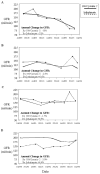Detection of renal function decline in patients with diabetes and normal or elevated GFR by serial measurements of serum cystatin C concentration: results of a 4-year follow-up study
- PMID: 15788478
- PMCID: PMC2429917
- DOI: 10.1681/ASN.2004100854
Detection of renal function decline in patients with diabetes and normal or elevated GFR by serial measurements of serum cystatin C concentration: results of a 4-year follow-up study
Abstract
Research on early renal function decline in diabetes is hampered by lack of simple tools for detecting trends (particularly systematic decreases) in renal function over time when GFR is normal or elevated. This study sought to assess how well serum cystatin C meets that need. Thirty participants with type 2 diabetes in the Diabetic Renal Disease Study met these three eligibility criteria: GFR >20 ml/min per 1.73 m2 at baseline (based on cold iothalamate clearance), 4 yr of follow-up, and yearly measurements of iothalamate clearance and serum cystatin C. With the use of linear regression, each individual's trend in renal function over time, expressed as annual percentage change in iothalamate clearance, was determined. Serum cystatin C in mg/L was transformed to its reciprocal (100/cystatin C), and linear regression was used to determine each individual's trend over time, expressed as annual percentage change. In paired comparisons of 100/cystatin C with iothalamate clearance at each examination, the two measures were numerically similar. More important, the trends in 100/cystatin C and iothalamate clearance were strongly correlated (Spearman r = 0.77). All 20 participants with negative trends in iothalamate clearance (declining renal function) also had negative trends for 100/cystatin C. Results were discordant for only three participants. In contrast, the trends for three commonly used creatinine-based estimates of GFR compared poorly with trends in iothalamate clearance (Spearman r < 0.35). Serial measures of serum cystatin C accurately detect trends in renal function in patients with normal or elevated GFR and provide means for studying early renal function decline in diabetes.
Figures



Similar articles
-
Serial measurements of cystatin C are more accurate than creatinine-based methods in detecting declining renal function in type 1 diabetes.Diabetes Care. 2008 May;31(5):971-3. doi: 10.2337/dc07-1588. Epub 2008 Mar 4. Diabetes Care. 2008. PMID: 18319326
-
Cystatin C is a more sensitive marker than creatinine for the estimation of GFR in type 2 diabetic patients.Kidney Int. 2002 Apr;61(4):1453-61. doi: 10.1046/j.1523-1755.2002.00253.x. Kidney Int. 2002. PMID: 11918752
-
Cystatin C is not more sensitive than creatinine for detecting early renal impairment in patients with diabetes.Am J Kidney Dis. 2001 Aug;38(2):310-6. doi: 10.1053/ajkd.2001.26096. Am J Kidney Dis. 2001. PMID: 11479157 Clinical Trial.
-
Serum cystatin C assay for the detection of early renal impairment in diabetic patients.J Clin Lab Anal. 2004;18(1):31-5. doi: 10.1002/jcla.20005. J Clin Lab Anal. 2004. PMID: 14730555 Free PMC article.
-
Commentary: clinical diagnostic use of cystatin C.J Clin Lab Anal. 2004;18(1):55-60. doi: 10.1002/jcla.10098. J Clin Lab Anal. 2004. PMID: 14730560 Free PMC article. Review.
Cited by
-
Therapeutic Modalities in Diabetic Nephropathy: Future Approaches.Open J Nephrol. 2012 Jun 25;2(2):5-18. doi: 10.4236/ojneph.2012.22002. Open J Nephrol. 2012. PMID: 23293752 Free PMC article.
-
Serum concentrations of markers of TNFalpha and Fas-mediated pathways and renal function in nonproteinuric patients with type 1 diabetes.Clin J Am Soc Nephrol. 2009 Jan;4(1):62-70. doi: 10.2215/CJN.03010608. Epub 2008 Dec 10. Clin J Am Soc Nephrol. 2009. PMID: 19073786 Free PMC article.
-
A comparison of change in measured and estimated glomerular filtration rate in patients with nondiabetic kidney disease.Clin J Am Soc Nephrol. 2008 Sep;3(5):1332-8. doi: 10.2215/CJN.05631207. Epub 2008 Jul 30. Clin J Am Soc Nephrol. 2008. PMID: 18667734 Free PMC article.
-
Effects of the dual peroxisome proliferator-activated receptor-α/γ agonist aleglitazar on renal function in patients with stage 3 chronic kidney disease and type 2 diabetes: a Phase IIb, randomized study.BMC Nephrol. 2014 Nov 18;15:180. doi: 10.1186/1471-2369-15-180. BMC Nephrol. 2014. PMID: 25407798 Free PMC article. Clinical Trial.
-
Biomarker for early renal microvascular and diabetic kidney diseases.Ren Fail. 2017 Nov;39(1):505-511. doi: 10.1080/0886022X.2017.1323647. Ren Fail. 2017. PMID: 28494191 Free PMC article. Review.
References
-
- Hsu C-Y, Chertow GM, Curhan GC. Methodological issues in studying the epidemiology of mild to moderate chronic renal insufficiency. Kidney Int. 2002;61:1567–1576. - PubMed
-
- K/DOQI clinical practice guidelines for chronic kidney disease. Evaluation, classification, and stratification. Am J Kidney Dis. 2002;39:S1–S266. - PubMed
-
- Price CP, Finney H. Developments in the assessment of glomerular filtration rate. Clin Chim Acta. 2000;297:55–66. - PubMed
-
- Viberti G, Walker JD. Natural history and pathogenesis of diabetic nephropathy. J Diabet Complications. 1991;5:72–75. - PubMed
Publication types
MeSH terms
Substances
Grants and funding
LinkOut - more resources
Full Text Sources
Other Literature Sources
Medical
Miscellaneous

